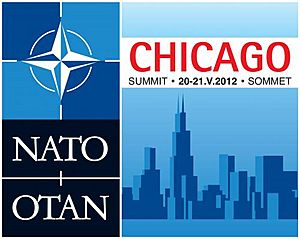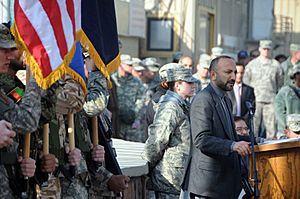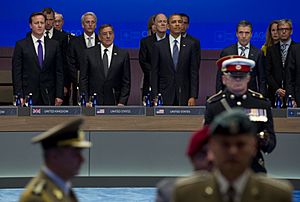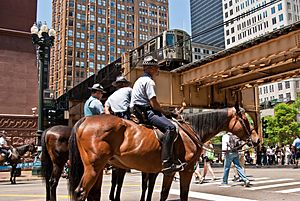2012 Chicago summit facts for kids
Quick facts for kids 2012 Chicago SummitNATO Summit Chicago 2012 |
|
|---|---|

Logo of the 2012 Chicago Summit
|
|
| Host country | United States |
| Date | 20–21 May 2012 |
| Venue(s) | McCormick Place |
| Cities | Chicago |
| Website | NATO Chicago Summit 2012 |
The 2012 Chicago Summit was an important meeting of the leaders from countries that are part of the North Atlantic Treaty Organization (NATO). It happened in Chicago, Illinois, on May 20 and 21, 2012. This was the first time a NATO summit was held in the United States outside of its capital, Washington, D.C. The meeting was first planned to happen after another big meeting, the G8 summit, also in Chicago. But the G8 summit was later moved to Camp David.
What Was Discussed at the Summit?
The leaders at the Chicago summit talked about many important world events that had happened since their last meeting in 2010. These included big changes in the Middle East, like the Arab Spring and the Libyan Civil War. They also discussed the worldwide money problems (the global financial crisis). A major topic was the plan for NATO forces in Afghanistan and how to protect Europe with a missile shield system.
Protecting Europe with Missiles
NATO leaders also talked about how to defend against missile attacks and how to use nuclear deterrence to prevent wars.
Secretary General of NATO Anders Fogh Rasmussen confirmed plans to build a system to defend against ballistic missiles. This system would help protect NATO countries from missile attacks, for example, from countries like Iran or North Korea. Rasmussen announced that a test of this missile defense system was successful in April 2012. More details about this system were shared at the Chicago summit.
The United States also planned to improve its tactical nuclear weapons in Europe. These upgrades would make the missiles more accurate.
Russia had asked NATO countries to follow international laws when making their nuclear plans at the summit. Russia also said it might react to NATO's defense system by using its own missiles or attacking weapon sites in Europe. However, experts believed Russia would not risk a war with the United States and its NATO allies.
NATO's Relationship with Russia
Russia was concerned that a full missile shield by the United States could make its own nuclear weapons less effective. Russia's nuclear weapons help keep a "strategic balance" between the two major powers. But the United States said the defense system was needed to deal with threats from Iran. In the past, Russia was invited to work with NATO on defense systems but declined. NATO also planned to review its overall relationship with Russia.
The War in Afghanistan

The war in Afghanistan was a big topic because Barack Obama had said that NATO's activities there would end by 2014. However, the 28 NATO countries had different ideas. For example, the new French President, Francois Hollande, said France would pull out all its troops by the end of 2012. This was two years earlier than NATO's planned timeline.
Key Decisions and Outcomes
Future of the War in Afghanistan
On May 21, 2012, NATO leaders agreed on a plan for ending the war in Afghanistan. They also promised to support Afghanistan for a long time. The NATO-led forces (ISAF) would give control of all combat missions to Afghan forces by mid-2013. At the same time, NATO would shift from fighting to helping. They would advise, train, and assist the Afghan security forces. Most of the 130,000 foreign troops would leave by the end of December 2014.
After 2014, a new NATO mission would continue to advise, train, and help the Afghan security forces. Each country would decide its own speed for withdrawing troops, but they would work together. Western officials said that countries with troops in Afghanistan promised about $1 billion to fund Afghan security forces after 2014. Most of this money would come from the United States. Later reports in June 2012 said that an annual aid of $4.1 billion was promised at the summit. This money would pay for ongoing training, equipment, and financial support for Afghanistan's security forces after 2014.
Smart Defense Initiative
Because countries had less money for defense, NATO leaders agreed to share the costs of weapons and equipment. This was called the "Smart Defense" initiative. NATO leaders approved 20 projects for this plan. These projects included funding for robots that clear roads of bombs and mines. They also planned to share maritime patrol planes and manage ammunition together. Other ideas included maintaining armored vehicles, sharing medical facilities, and managing fuel. They also planned to work together on surveillance aircraft and buy Global Hawk surveillance drones for all member states.
NATO Secretary General Anders Fogh Rasmussen explained that "Smart Defense" was needed because military budgets were being cut. He said that countries needed to save money during the Great Recession. He believed that by working together, NATO could still be ready for future security challenges.
The "Smart Defense" idea was inspired by comments from U.S. Secretary of Defense Robert Gates in 2011. He said that NATO might face a difficult future if European countries didn't spend enough on defense. Only a few European countries met NATO's goal of spending two percent of their GDP on defense. The United States, which pays most of NATO's operating budget, was also facing budget problems.
Smart Defense aims to make Europe more responsible for its own security as the United States military reduces its presence there.
Missile Defense System
During the 2010 Lisbon summit, NATO members agreed to create a missile defense system. This system would protect all member states in Europe, as well as the United States and Canada. In Chicago, NATO leaders announced that this system had reached "interim capability." This means a basic command and control system was tested and set up in Germany. NATO allies also provided sensors and interceptors to connect to the system. It also means that U.S. ships with anti-missile interceptors in the Mediterranean Sea and a radar system in Turkey were put under NATO command.
NATO Secretary General Anders Fogh Rasmussen said, "Our system will link together missile defense assets from different Allies. These include satellites, ships, radars, and interceptors. All will be under NATO command and control. It will allow us to defend against threats from outside the Euro-Atlantic area."
The NATO missile defense system was expected to have limited ability by 2015 and be fully working by 2018. NATO's long-term goal is to combine missile defense tools from individual allies into one system. This would provide full protection for all NATO European people, land, and forces against ballistic missile threats. This goal is expected to be reached between the late 2010s and early 2020s. To help with this, Spain will host four U.S. Aegis warships. Poland and Romania have also agreed to host U.S. land-based SM-3 missiles in the coming years.
Protests During the Summit
Several thousand protesters marched through downtown Chicago. They got as close as they could to the buildings where the NATO leaders were meeting. There, 50 members of Iraq Veterans Against the War threw away medals they had received during missions in Afghanistan and Iraq. This was a symbol of their protest against the wars. Each veteran explained why they were leaving the army and their experiences in the wars as they threw their medals. Activists from Afghans for Peace also spoke to the crowd, representing the voices of Afghan civilians affected by the war.
Organizers expected the NATO summit to attract protesters from the Occupy movement and the anti-globalization movement. Many protesters came from around the world. Some private schools near the meeting site thought about closing for the event. However, no Chicago Public Schools closed, even those nearby.
Security Measures
The summit was named a "National Special Security Event" (NSSE) by the Department of Homeland Security. This meant the Secret Service had the final say over security. Local police forces were trained to handle crowds if needed. Police were trained in special control techniques and how to use tasers.
The city also bought new face shields for police that fit over gas masks. These shields were to protect officers from liquids. The Chicago Police Department also prepared its mounted unit (police on horses) with riot gear. This included armor for the horses and training for crowd control.
New Chicago Rules
Chicago mayor Rahm Emanuel proposed and passed new rules. These rules were made permanent, even after the summit ended. The new rules included:
- Allowing the mayor to buy and use surveillance cameras all over the city.
- Limiting public activities, like loud sounds and morning gatherings.
- Putting limits on parades, including needing to buy a $1 million insurance policy. Also, every sign or banner held by more than one person had to be registered.
- Allowing the Chicago Police Superintendent to give police powers to other law enforcement people if needed.
These new rules caused protests from groups like the ACLU and Amnesty International. The Occupy Movement (especially Occupy Chicago) also protested them.
Summit Expenses
On June 29, 2012, the city of Chicago presented a bill for almost $15.6 million for the NATO summit. Most of this money was for the police department. They had millions of dollars in overtime, training, and other costs. The city asked for $14.6 million for police services. The rest of the bill, a little less than $1 million, was for fire department services. The city said more bills would be coming.
See also
 In Spanish: Cumbre de Chicago de 2012 para niños
In Spanish: Cumbre de Chicago de 2012 para niños



